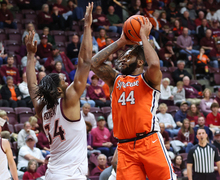Thornden Park gets ready for spring with restoration projects
Kai Nguyen | Photo Editor
Miranda Hine started the Thornden Park Association in the 1980s and has worked since then to restore the 76-acre park.
When Miranda Hine first moved to Syracuse in the 1980s, Thornden Park was in a state of disrepair. It had a reputation for being dangerous, but Hine and her children frequently visited the park because she never felt unsafe. Hine then rallied together a group of neighbors to form the Thornden Park Association.
Over the last 35 years, Hine has spearheaded restoration efforts of the 76-acre park to revitalize it into what the association believes a park should be like. Today, the association is working on a handful of projects to get the park ready for the spring season. The largest projects are the renovation of the amphitheater to improve its accessibility and repairs on the mechanical space under the stage.
The amphitheater work is estimated to cost about $1 million, said Matt Oja, the current vice president of the Thornden Park Association. He joined the organization as a volunteer in 2013, right after graduating from the Syracuse University College of Law.
The pace of the restorations are contingent on the grants and funds the organization can receive, Oja said. Each year, they apply for grants to get funding for their various projects, many of which are finished over a period of time because they can’t always get the necessary funding at once. The restoration of the park’s brick pathways has been ongoing for the last ten years, Oja said.
Other recent projects include fixing the children’s playground and the creation of an entirely new exercise course. Hine said the organization’s goals are gradually being realized.
“The thing that has changed in the last 30 years is that it’s become more vibrant and people (are) using it more and that was our main goal — to get people into the park and using it,” Hine said.
The park also has a number of events planned for the spring and summer, including a volunteer project for Earth Day. Hine said volunteers often assist in park maintenance. This year, the SU group Orange Seeds will be helping with the Earth Day event.
The next major social event the organization is planning will be a biathlon held in conjunction with the University Neighborhood Preservation Association in July, Oja said. It will be a sprinting and running event for children in the park. During the summer, the park hosts five weeks of camp for children.
Restoration efforts began in the mid-80s with the Lily Pond, which took seven years to complete, Hine said. The organization also restored the Carriage House on the northern end of the park, which Hine said was scheduled to be torn down.
With support from the city’s parks and recreation department, and a grant, the house was able to survive. It now houses an exercise class and discovery camps in the summer.
Regarding safety in the park, Hine and Oja reiterated that the rhetoric from SU’s Department of Public Safety surrounding the crime rates in the park has definitely affected student attendance.
“DPS especially contributes to a perception of lack of safety in the park,” Oja said. “But we tend to find, anecdotally, that when students do have direct interaction with the park, they enjoy it, they get a lot of use out of it. But there is a little bit of a barrier that they need to overcome when being introduced to Syracuse — that the park is there for their use and they can and should make the most of it.”
There has been a problem with SU students vandalizing the park, Oja said, but the more people who use the park, the more eyes will be on the park which should enhance the perception of safety.
Hine said she would encourage people to enjoy both the historic and aesthetic features of the park.
“I think (there is) value in green space in the city for people who don’t have cars and can’t go into the suburbs or up into the Adirondacks,” Hine said. “I think it makes for a vibrant neighborhood to have places where children and adults can go jog and run or swim or play or whatever it is they like to do, whether it is active or passive, it’s really important to have that in the city.”
Published on March 27, 2018 at 10:11 pm
Contact Jony: ktsampah@syr.edu






